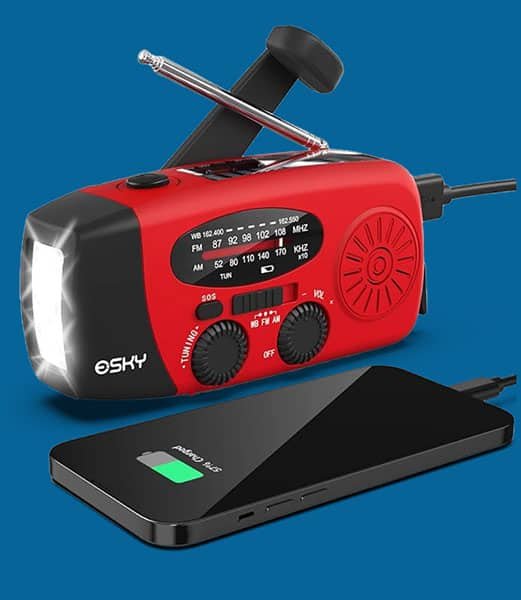A typical North Dakota homeowners’ policy is written through Farmers, State Farm, Allstate, and Progressive, for instance, excludes flooding as something that will be covered under their homeowner’s policy.
In most cases, the only way to get flood coverage is by purchasing a stand-alone flood insurance policy. However, you should ask your homeowners agent if you can add an endorsement to your homeowner’s policy to cover flooding. Yet, don’t be too surprised if the answer is NO.
It is important to have flood insurance coverage in North Dakota because our beloved Cowboy State has seen a fair share of flooding, and there is likely more coming.
We believe that most homeowners think about Flood insurance in North Dakota at some point, maybe before buying a home, or during the closing process. However, many of us only think about it when a big storm is looming, or we have heard on the news that there is flooding forecasted or happening currently too close to our home.
If your home or business is in a flood zone, that is considered low flood risk area. Sadly, many homeowners decide to forgo purchasing coverage because they believe they are safe from flooding. Some real estate agents and some insurance agents may even say you don’t need it.
I ask you to consider the facts: 20-percent of all flooding events across our nation come in areas that are considered low risk. After our last few major storms (Hurricane Harvey), we saw flooding in these low-risk areas. In 80 percent of these individuals, they had water in their home or buildings and didn’t have flood insurance coverage.
In Harris county, nearly 135,000 homes were damaged. Three-fourths of these properties were considered low to moderate risk.
We hear often that people believe that the government will help, and this is true. However, there are a few things that must align for you to get government assistance.
1 – The president of the United States must declare the flooding event a state of emergency. If this doesn’t happen, then there won’t be assistance.
2 – The average amount of assistance that homeowners get after a flood, when they do not have flood coverage, is $5,000. The average cost of damage to one’s property after a flood is $38,000+. That $5K you get from the government? It comes in the form of a loan and you will need to pay it back. Are you willing to gamble away your financial future by forgoing flood insurance coverage?
One more note on these low-risk flood zone maps. Many of these maps are over 40-years old. If the area has been developed, then there is likely more concrete, creating a barrier for land that previously, might have absorbed the massive downpour.
Because of all these factors, it is difficult for property owners to know their true risk of flooding. FEMA admits that their flood maps only give an idea for part of the risk. Our recent storms are facts that it can rain anywhere within North Dakota, and you should consider getting flood coverage, so you are not uninsured when you need it most.
FEMA flood zone maps often take years to go into effect after the terrain was studied, this gives the impression that the area is “more up to date” then it really is.
North Dakota NFIP flood insurance.
There are many options available in North Dakota regarding flood insurance, but they basically fall into two main categories.
1 – The National Flood Insurance Program (NFIP), also known as FEMA, which is the government option for flood insurance. The NFIP has enjoyed a 50-state monopoly on the flood insurance market.
2 – Not “private flood insurance” but NFIP Resellers
If you have Nationwide Flood Insurance, State Farm Flood Insurance, Progressive Flood Insurance, or any of the of the logos below then you are buying the NFIP flood policy that is just being resold through a government program. These companies are private companies, but their flood insurance is not. Here is a list of the 70 companies that resell the NFIP policy.
North Dakota is fortunate to have many Lloyds of London flood insurance options. Although many Lloyds flood insurance companies will have you assume that there is only one option, nothing could be further from the truth.
Lloyds of London has a rich history and is attributed to have invented the very first modern insurance model. Unlike most of its competition, Lloyds of London is not really a company but rather a corporate body. This structure works quite well since it has been around for over 330 years. Lloyds operates under multiple financial backers that all pool their capital to spread the risk.
I have two blog posts that take a deep dive into Lloyds of London and what they mean to North Dakota’s flood insurance market. If you are interested, the links are below.
Lloyds also insures the world for flood insurance, meaning they cover flooding events in India, Australia as well as much of Europe. You see the “game” of insurance is to spread your risk since Lloyds is worldwide.
My joke here is that Lloyds is banking on Gods promise that he won’t flood the entire world again, …..so they won’t have to pay out the whole worlds flood claim.
There are many factors that go into getting the cost of flood insurance for North Dakota. If your home is in what is considered low-to-moderate risk, you can get a heavily subsidized policy though the government.
North Dakota flood insurance low-to Moderate Risk rate and cost.
This is Flood Zone X, which is not lender required flood zone.
This is usually identified as an X-flood zone. Then we would suggest the government Preferred Risk Policy (PRP) which is a subsidized policy and has set flood insurance coverage limits (see grid below):
The average cost for flood insurance in North Dakota with the maximum set limits in these Low-risk flood zone areas is $405 – $700 per year.
If your property is in higher-risk flood zone, it is usually identified with a Flood Zone AE. Your lender will require you to have flood insurance. The cost of flood insurance in North Dakota depends on many factors that are unique to the structure. We are going to try to give you an idea for the most common homes we see in North Dakota with a slab on grade foundation.
We will look at the North Dakota cost of flood insurance for the NFIP maximum of $250,000 for the (building only) with NO CONTENTS and our recommended deductible of $5,000.
We will be rating this example on the NFIP, as well as on a few of our private flood insurance policies, specifically Lloyds flood insurance options in North Dakota.
Our example is in Fargo, but the premiums will be the same if in Bismarck, Valley City, Burleigh, Grand Forks, and many other North Dakota flood zones.
In our example, the Base Flood Elevation (BFE is 5368) and is a home that is built before 1973
NFIP option in North Dakota Flood Zone AE
NFIP – Coverage of $250,000 building coverage (no Contents coverage) and $5,000 deductible
NFIP Annual premium in High-Risk flood zone is $2,300
This option is what we see if the property has had a flood loss before, and either doesn’t have an Elevation Certificate applied or the Elevation certificate showing that the lowest floor is 4 feet under the BFE for the area. You can use 10% of your coverage to cover other structures on your property
North Dakota Private flood insurance – Lloyds of London Flood Insurance (option 1)
Coverage of $250,000 building coverage (no Contents coverage) and $5,000 deductible
Lloyds of London (option 1) Annual premium in High-Risk flood zone is $689.00
This option is great, and we are very happy when we can get this option. They can be a bit choosey about what risk they will accept and will not take anything that has had a flood loss. They do offer coverage for basements, about $2,000 for loss of use, $2,000 for other structures, but they can’t increase this coverage. They do not require an Elevation Certificate to rate.
North Dakota Private flood insurance – Lloyds of London Flood Insurance (option 2)
Coverage of $250,000 building coverage (no Contents coverage) and $5,000 deductible
Lloyds of London (option 2) Annual premium in High-Risk flood zone is $950.00
This option is great, and we are very happy when we can get this option for our clients as well. They seem to be writing almost all risks; however, they do not write any property that is in a designated floodway or has the depth of -4 under the BFE. In our example, with our BFE being 5368, if the lowest floor is 5364, then they will not accept this risk. They will not take anything that has had a flood loss. They do offer limited coverage for basements and do not require an Elevation Certificate to rate, and as a percentage of coverage for loss of use. If you want coverage for other structures, then that will need to be added.
Private Flood insurance option (option 3)
Coverage of $250,000 building coverage (no Contents coverage) and $5,000 deductible
Private flood insurance (option 3) Not Lloyds,
Annual premium in High-Risk flood zone is $1,500
This option will take properties that have had one flood loss as long as it has been more than five years, and the payout was under $100,000 on the claim. Their coverage matches the NFIP. They will write practically all risks, don’t need an elevation certificate to rate, and are a bit lower in premium than the NFIP.
Private Flood insurance – Lloyds of London (option 4)
This option must be written on the Replacement Cost Value (RCV) of the building, otherwise there is a co-insurance penalty that kicks in. So, $250,000 might be a bit low in California, but to keep this going, let’s just use that for this option
Coverage of $250,000 (RCV) building coverage, No Contents and $5,000 deductible
Annual premium in High-Risk flood zone is $619.20 (great price).
This options rating system is all over the board. Sometimes we get a crazy great price, but other times the premium is way higher than the NFIP will consider taking a property that has had one flood loss before as long as it has been more than ten years and the payout was under $50,000 on the claim. Their preferred coverage is at replacement cost, which is a bit different from some of our other Lloyd’s flood options. We usually reserve this one if the property doesn’t fit into any of our options above. We can adjust coverages to control premium. As mentioned before, this underwriters’ rates are all over the board. It is worth shopping through to make sure we are getting you the best premium we can. They don’t need an elevation certificate to rate.
Private Flood insurance – Lloyds of London (option 5)
Coverage of $250,000 (RCV) building coverage, No Contents and $5,000 deductible.
Annual premium in High-Risk flood zone is $1,915.86
This option came out of the company that used to run the NFIP program, so the coverage almost exactly matches the NFIP coverage with two differences. They offer living expenses which will cover your cost, when you are displaced from your home during repairs (most Lloyds flood policies offer this). They also offer swimming pool clean out, which is kind of unique so if you have a pool ask for this coverage.
Private Flood insurance – Lloyds of London (option 6)
Coverage of $250,000 (RCV) building coverage. No Contents and $5,000 deductible.
Annual premium in High-Risk flood zone is $2,904.05
This options rating system is also all over the board. Sometimes we get a crazy low price; other times the premium is way higher than the NFIP. They will consider taking a property that has had one flood loss before as long as it has been more than ten years and the payout was under $25,000 on the claim. They have been rumored to give a low price the first year and then non renew following years or sometimes they jack the price way up so we will watch them. They have a slick system, and their underwriting is managed by a 3rd party, which also seems to be a glitch sometimes.
There are more options coming online every day, and we are working to be looking into every viable option.









